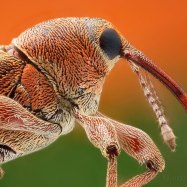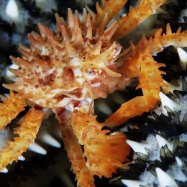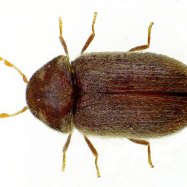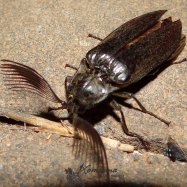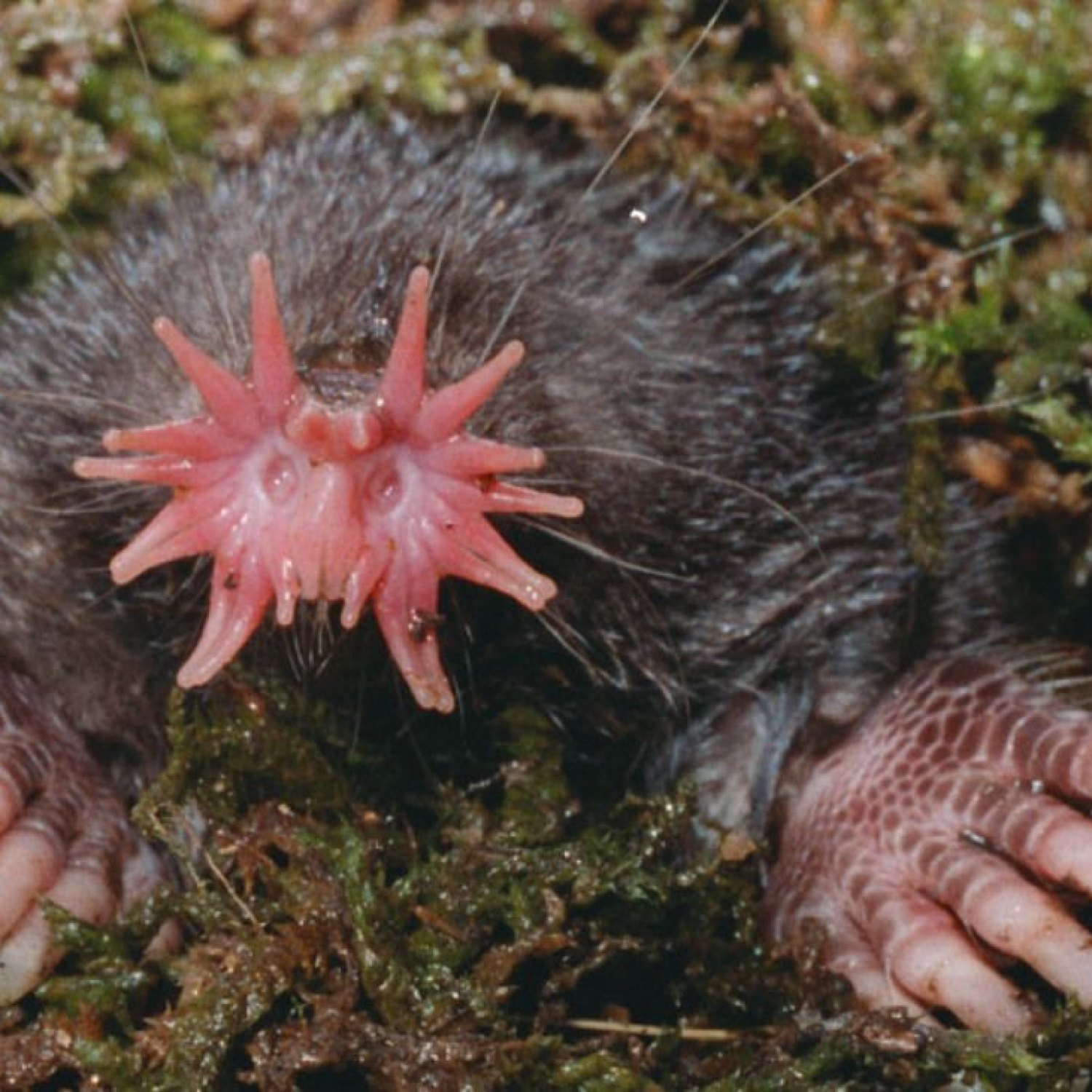
Star Nosed Mole
15 to 20 centimeters (6 to 8 inches)
The Star Nosed Mole is a fascinating creature found in Eastern North America. With a body length of 15 to 20 centimeters, this small, cylindrical, and elongated mammal belongs to the Talpidae family. Its unique feature is the star-shaped nose, used for sensing prey. Despite its odd appearance, the mole plays an important role in their ecosystem. #StarNosedMole #FascinatingFacts #EasternNorthAmerica
Animal Details Summary:
Common Name: Star Nosed Mole
Kingdom: Animalia
Habitat: Semi-aquatic habitats including marshes, swamps, and wet meadows
The Incredible Star Nosed Mole: A Unique Creature of Eastern North America
Hidden within the wetlands of eastern North America lies a creature with a unique feature that sets it apart from all other mammals – the Star Nosed Mole. This small but fascinating animal, with its distinctive snout resembling a star, is a master of surviving in semi-aquatic habitats. Its scientific name, Condylura cristata, directly translates to "wrinkled nose with a crest" which perfectly describes its most prominent feature. But there is so much more to this creature than just its peculiar snout Star Nosed Mole. Let's dive into the details of the Star Nosed Mole and discover what makes it truly one of a kind.A Unique Classification
The Star Nosed Mole belongs to the Animalia kingdom, making it a part of the vast and diverse animal world. Within this kingdom, it falls under the Chordata phylum, which means it has a spinal cord and a backbone. Further categorizing it, the Star Nosed Mole is a member of the Mammalia class, identifying it as a warm-blooded animal that nourishes its young with milk. Within the mammalian class, it belongs to the order Eulipotyphla, which includes shrews and other mole species. Finally, the Star Nosed Mole falls under the Talpidae family, indicating that it is closely related to other mole species.A Semi-Aquatic Lifestyle
One of the most intriguing facts about the Star Nosed Mole is its habitat. This mole has adapted to a semi-aquatic lifestyle, and its home is in wetlands which include marshes, swamps, and wet meadows. It spends most of its time underground, although you may occasionally spot it swimming or foraging on the surface Sable Ferret. Its small webbed front paws and long, thick tail make it an excellent swimmer. This ability to thrive in both land and water allows the Star Nosed Mole to have access to a diverse range of food sources and also provides protection from predators.Carnivorous Diet
The Star Nosed Mole is a carnivorous animal, meaning it feeds primarily on meat. Its diet consists of insects, worms, small fish, and amphibians, making it an essential part of the wetland ecosystem. However, what is truly remarkable about its feeding method is the speed at which it can obtain and consume its prey. The 22 tentacles surrounding its star-shaped nose are extremely sensitive, helping it detect and capture prey in a matter of milliseconds. This makes the Star Nosed Mole one of the fastest foragers in the animal kingdom.Geographical Distribution
Unlike many other species with a wide distribution, the Star Nosed Mole is a highly localized animal. Its natural habitat includes eastern parts of the United States and Canada, making it only found in a specific part of North America. This limited range makes it even more unique and increases its value to the biodiversity of the region.A Stunning Appearance
The Star Nosed Mole may not be the most visually appealing creature, but it certainly has some distinct features that make it stand out. Its suede-like fur is dark brown to black, giving it a sleek and shiny appearance. Its body shape is small, cylindrical, and elongated, allowing it to easily navigate through tunnels and burrows. But what catches everyone's attention is its unique star-shaped nose which is unlike any other mammal. It contains 22 fleshy tentacles, each lined with sensory receptors that aid in locating and identifying prey.Size and Length
As mentioned earlier, the Star Nosed Mole is a small creature. On average, it reaches a length of 15 to 20 centimeters, or 6 to 8 inches. However, its amazing adaptation has allowed it to be powerful beyond its size. The Star Nosed Mole is known to be one of the strongest mammals, being able to dig through soil at an incredible speed of 1 foot per 5 seconds!A Marvel of Evolution
Scientists believe that the Star Nosed Mole's unique nose is a result of evolution. Its semi-aquatic lifestyle and feeding habits have led to the adaptation of an organ that is perfectly fit for its environment. The star-shaped nose not only helps the mole navigate and find food but also provides a way to expel unwanted water when submerged. The 22 tentacles allow for sensitive touch, making the Star Nosed Mole a master of hunting in the dark, murky waters of its habitat.A Fascinating Creature for Research
The Star Nosed Mole has caught the attention of many researchers and scientists, mainly due to its specialized sensory organ. It is an essential focus of studies related to neurology and mammals' sensory systems. The mole has also inspired engineers in the development of certain technologies such as tactile sensors and navigation systems. Its distinctive features and unique abilities continue to amaze people and make it a valuable subject for research.A Creature to Protect
The Star Nosed Mole may not be a well-known animal, but it plays a significant role in its ecosystem. Its habitat is under constant threat due to urbanization and human activities, leading to a decline in its population. The construction of highways and buildings destroy its wetland habitat, leaving the Star Nosed Mole with limited resources to survive. It is crucial to raise awareness about the value and importance of preserving the wetlands where this incredible creature calls home.In Conclusion
In the vast world of animals, the Star Nosed Mole is truly one of a kind. Its unique adaptation to a semi-aquatic lifestyle, carnivorous diet, distinctive features, and limited geographical range make it a fascinating and valuable creature. Its astounding ability to detect and consume prey in a fraction of a second has captured the attention of scientists and researchers. As we continue to discover more about this creature, it is essential to protect its habitat and ensure its survival for future generations to appreciate and admire the marvels of evolution.

Star Nosed Mole
Animal Details Star Nosed Mole - Scientific Name: Condylura cristata
- Category: Animals S
- Scientific Name: Condylura cristata
- Common Name: Star Nosed Mole
- Kingdom: Animalia
- Phylum: Chordata
- Class: Mammalia
- Order: Eulipotyphla
- Family: Talpidae
- Habitat: Semi-aquatic habitats including marshes, swamps, and wet meadows
- Feeding Method: Carnivorous
- Geographical Distribution: Eastern North America
- Country of Origin: United States and Canada
- Location: Eastern North America
- Animal Coloration: Dark brown to black
- Body Shape: Small, cylindrical, and elongated
- Length: 15 to 20 centimeters (6 to 8 inches)
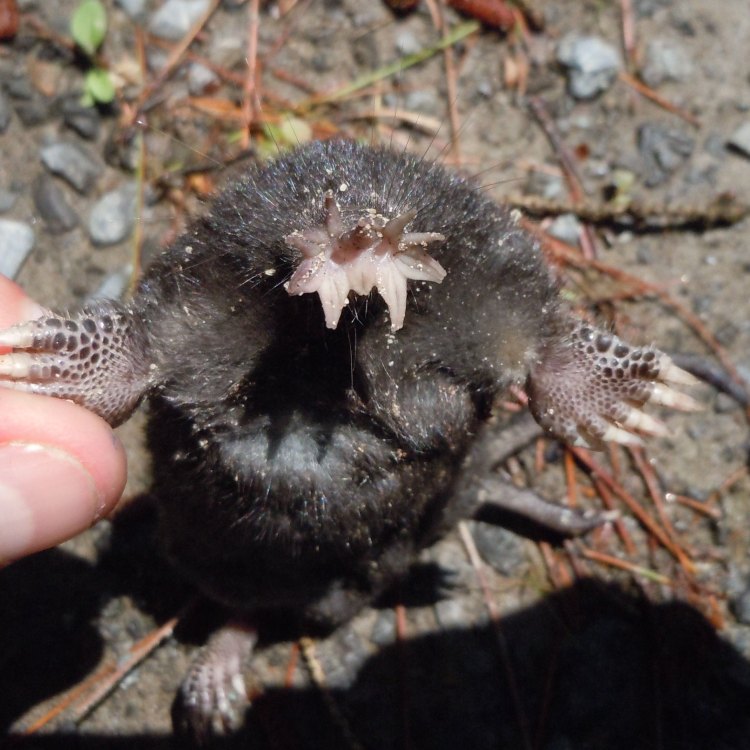
Star Nosed Mole
- Adult Size: 15 to 20 centimeters (6 to 8 inches)
- Average Lifespan: 3 to 4 years
- Reproduction: Sexual
- Reproductive Behavior: Polygynandrous (promiscuous)
- Sound or Call: Produce clicking sounds
- Migration Pattern: Non-migratory
- Social Groups: Solitary
- Behavior: Nocturnal, highly active
- Threats: Habitat loss, pollution, predation
- Conservation Status: Least Concern
- Impact on Ecosystem: Important ecosystem engineers
- Human Use: No significant human use
- Distinctive Features: Star-shaped fleshy nasal appendages
- Interesting Facts: Has the ability to detect prey underwater using its sensitive nose
- Predator: Various predators including owls, hawks, foxes, and snakes
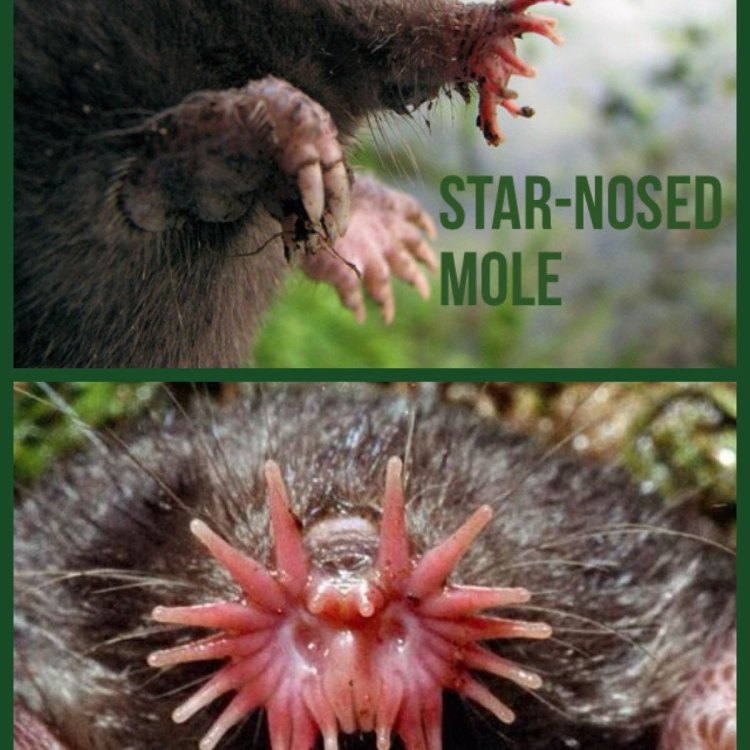
Condylura cristata
The Incredible Adaptations of the Star Nosed Mole
When you think of a mole, the first image that may come to mind is a small, furry creature with dark, beady eyes and long claws, scurrying through underground tunnels. However, there is one particular mole species that stands out among the rest with its distinctive features and impressive adaptations – the star-nosed mole.The star-nosed mole, also known as Condylura cristata, is a small mammal that is native to eastern North America. Its unique appearance is marked by the presence of 22 fleshy, pink appendages that encircle its nose, forming a star-like shape PeaceOfAnimals.Com. These appendages, called tentacles, are incredibly sensitive and serve as a highly specialized organ for hunting and navigating its environment.
In this article, we will delve deeper into the fascinating world of the star-nosed mole and discover the many ways in which it has adapted to survive and thrive in its environment.
The Basics: Size, Lifespan, and Reproduction
The star-nosed mole is a small animal, measuring about 15 to 20 centimeters (6 to 8 inches) in length, with a short, stocky body and a long, cylindrical snout. It is a relatively short-lived animal, with an average lifespan of 3 to 4 years in the wild.When it comes to reproduction, the star-nosed mole follows a sexual reproduction pattern. This means that males and females must mate in order to produce offspring. However, their reproductive behavior is what truly sets them apart from other animals.
Promiscuous by Nature: The Unique Reproductive Behavior of the Star-Nosed Mole
Unlike most mammals, which are either monogamous (mating with only one partner) or polygamous (mating with multiple partners), the star-nosed mole follows a unique pattern known as polygynandrous, or promiscuous, behavior.In simple terms, this means that both males and females have multiple sexual partners Sarcosuchus. During mating season, which typically occurs between March and April, female star-nosed moles will mate with multiple males, and likewise, male moles will mate with multiple females.
This behavior is thought to be due to the species' solitary nature, with individuals spending most of their time alone in underground tunnels. By mating with multiple partners, they increase their chances of reproductive success and passing on their genes.
Communicating Through Clicks: The Fascinating Vocalizations of the Star-Nosed Mole
Most mammals use vocalizations as a means of communication, and the star-nosed mole is no exception. However, rather than making traditional animal sounds like barks or growls, the star-nosed mole produces distinctive clicking sounds.These clicks are believed to serve as a form of echolocation, helping the animal navigate and find prey in its dark, subterranean habitat. They are also used in social situations, with individuals communicating through different patterns and frequencies of clicks.
Homebodies: The Non-Migratory Nature of Star-Nosed Moles
Unlike some other animals that migrate to different regions to find food or mate, star-nosed moles are non-migratory creatures. They remain in their underground tunnel systems for their entire lives, only venturing outside to forage for food or during mating season.This behavior may be due to their highly specialized adaptations for underground life, such as their thick, almost waterproof fur and their sensitive snouts, which can easily detect prey even in the dark.
Solitary Creatures: The Social Life of the Star-Nosed Mole
Star-nosed moles are solitary animals, meaning they spend most of their time alone and do not form social groups or colonies like some other species. This is believed to be because their hunting and feeding habits do not require them to live in a group, and competition for resources is low in their underground habitat.However, researchers have noted that star-nosed moles do occasionally interact with one another, particularly during mating season when males compete for the attention of females.
Incredibly Active and Nocturnal: A Day in the Life of a Star-Nosed Mole
Despite their small size, star-nosed moles are incredibly active and have a high metabolic rate. They are also nocturnal animals, meaning they are most active at night, using their keen senses to navigate through underground tunnels and hunt for prey.Their diet mainly consists of invertebrates such as worms, insects, and snails, which they detect using their sensitive nose. Interestingly, they have also been observed diving in shallow water to hunt for prey, showcasing their adaptability and unique hunting techniques.
The Threats Facing Star-Nosed Moles and the Importance of Conservation
Like many other animals, star-nosed moles face several threats in their environment. Habitat loss due to development and urbanization is one of the main threats to this species, as their underground tunnels and burrows can be destroyed or disturbed.Pollution and water contamination also pose a danger to these animals, with chemicals seeping into the groundwater and affecting their food sources. Additionally, they are preyed upon by various predators, including owls, hawks, foxes, and snakes.
Due to these threats, the star-nosed mole has been listed as a species of Least Concern on the IUCN Red List. However, it is important to continue monitoring their populations and protecting their habitat to ensure their survival.
The Impact of Star-Nosed Moles on Ecosystems
Despite their small size and solitary nature, star-nosed moles play an important role in their ecosystem as ecosystem engineers. Their digging and tunneling activities help aerate the soil and cycle nutrients, benefiting other plant and animal species.Their presence also helps to control the population of invertebrates in their habitat, which can have a significant impact on plant growth and other animal populations. Without these creatures, the ecosystem would be disrupted, emphasizing the importance of their conservation.
Curiosity and Research: The Quest to Understand the Unique Adaptations of the Star-Nosed Mole
The distinctive features and fascinating behaviors of the star-nosed mole have captured the interest and curiosity of researchers for many years. Their specialized nasal appendages, in particular, have been the focus of much study and speculation.Scientists are currently exploring how these appendages work and what sort of information they provide to the mole, as well as how the animal uses them to navigate, find food, and communicate with others.
The Star-Nosed Mole and Humans: A Relationship of Mutual Respect
Unlike some other animals, the star-nosed mole has no significant use for humans and does not directly impact our lives in any way. However, as with all living creatures, we should respect and protect their habitats to ensure their survival and maintain balance in our ecosystems.The unique adaptations and behaviors of the star-nosed mole serve as a reminder of the diverse and wondrous world of nature, and the importance of preserving and admiring it for generations to come.

The Incredible Star Nosed Mole: A Unique Creature of Eastern North America
Disclaimer: The content provided is for informational purposes only. We cannot guarantee the accuracy of the information on this page 100%. All information provided here may change without prior notice.




